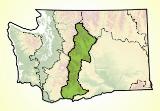 © Pete Saloutos/Panoramic Images (Washington Title Image Large)
© Pete Saloutos/Panoramic Images (Washington Title Image Large)

East Cascades Human Impact
While much of the ecoregion retains natural or semi-natural vegetation, the native biodiversity of the East Cascades ecoregion has been affected by many human activities. Some of the conservation challenges are:
- Habitat loss and fragmentation. The dry ponderosa pine forests, by recent estimates, cover only 1% of their original range. Customary forest management practices, including high grading and selective harvest of big trees, and rural residential development have been among the stresses on these open, park-like stands.
- Altered fire regimes. Larger, less frequent fires are more common now, after nearly a century of fire suppression. Brush and ladder fuels, formerly cleared by low intensity fires every 5 to 15 years, have accumulated. These have both changed forest structure and increased the hazard of catastrophic blazes.
- Recreation impacts. Off-road vehicles, horse traffic, bikers, and hikers can damage fragile soils and introduce invasive species. Snowmobilers and skiers risk disturbing the homes of the few remaining lynx and wolverines.
Within the ecoregion, a number of conservation partnerships are working together to meet these and other biodiversity conservation challenges.
For details of this ecoregion within Washington, click a subheading in the left column.
View the more general description of this ecoregion in North America



